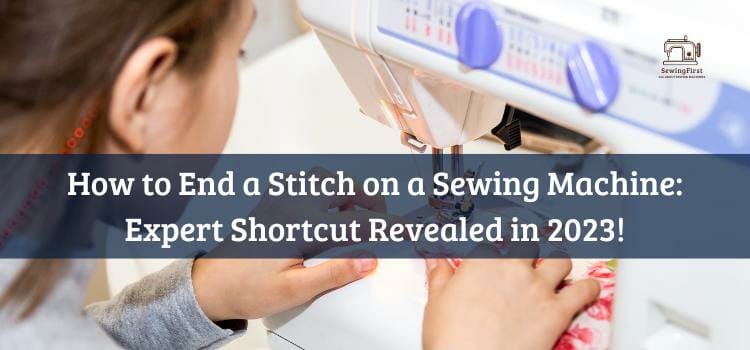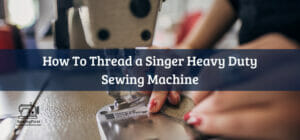Have you ever been in the middle of a sewing project and needed to know how to end off your stitch? It can be daunting if you don’t know what to do. But ending off your stitching isn’t as hard as it seems, especially with a few tips from an experienced sewer. We’ll show you exactly how to finish a stitch on a sewing machine so that your projects turn out to look perfect every time!
No matter whether you’re new or experienced when it comes to sewing, having the correct technique for finishing off stitches is essential. With just a few simple steps, anyone can easily wrap up their projects with perfection – no stress required!
In this article, we will cover all the best practices for finishing off stitches on any type of sewing machine. From threading the needle correctly, locking your stitch into place, and even using special tools like seam finishers or hem guides – we’ve got everything covered.
Are you ready to take your stitching skills up a notch? Then let’s get started learning how to end a stitch on a sewing machine!
Related Topic: How To Secure a Stitch With Sewing Machine: Learn The Perfect Stitch!
Table of Contents
ToggleOverview Of Stitching Techniques
Sewing is a creative art form and for many, an enjoyable hobby. Whether you’re using a hand-stitch or a sewing machine to create your project, the end result will depend on how well it’s finished. Finishing stitches correctly can make all the difference in the quality of your work.
The straight stitch is one of the most common stitching techniques used with a sewing machine. This type of stitch is created by moving up and down along two raw edges while keeping them even, which is often done with presser feet and foot pedals.
With this type of stitch, it’s important to ensure that your ends are securely fastened together so they don’t come apart while being handled or worn.
This brings us to the end of the straight stitch when using a sewing machine – something that requires skill and attention to detail. The objective here isn’t just about making sure that the seam looks neat but also ensuring that there won’t be any gaps between both sides of the fabric where a thread could get caught or unraveled over time.
Achieving this level of precision takes practice but once mastered, you’ll be able to finish projects with beautiful results! To do this right, we must now focus on selecting appropriate threads for our next step.
Choosing Appropriate Threads
When it comes to ending a stitch on a sewing machine, the type of thread you choose makes all the difference. Take for example Mary, who was making an intricate quilt but ended up with fraying threads after trying to sew together two pieces of fabric. It turns out that she wasn’t using the right kind of thread; opting for cotton instead of a stronger material like polyester would have made her project more durable and prevented any future issues.
To avoid mistakes such as this one, always use high-quality threads with strong fibers in your projects. Make sure to check the spool size before beginning too – if there are not enough yards or meters available, switch it out for something larger so you won’t run short while stitching! Once everything is ready to go, it’s time to start cutting your thread with scissors or a specialized thread cutter.
Now that you have chosen and cut the appropriate length of thread needed, begin by tying a double knot at each end of your seam line. This will help secure both ends and prevent them from coming apart when handled roughly or pulled on during wear.
To finish off your work properly, create a finishing knot by looping the loose end through itself multiple times before pulling tight. This step ensures that no gaps appear between fabrics where unwanted materials could get stuck over time. With these steps completed successfully, you’re now ready to set up your sewing machine and put those skills into practice!
Setting Up The Sewing Machine
Once you have prepared the thread, it’s time to set up the sewing machine. First, take a spool of your chosen thread and feed it through the top thread guide on the side of your machine before winding it onto the bobbin case.
Make sure that any excess thread tail is tucked away correctly so that it won’t get caught in the mechanism later! Next, locate the needle threader (if available) or manually pass your needle through both ends of a piece of thread – this will help keep it secure when stitching.
Finally, make sure to read through your machine manual for specific instructions; each model may have slightly different settings depending on what type of project you are working on.
Before beginning work, double-check all connections: ensure there are no loose threads or tangled pieces around the spool holder or upper tension discs as these can cause skipped stitches and other issues down the line. With everything now ready to go, you can begin inserting a needle into place and start creating something beautiful.
Inserting A Needle
As the old adage goes, “A stitch in time saves nine” – and there’s no truer statement when it comes to sewing. Inserting a needle correctly is essential for creating beautiful, even stitches; otherwise, you may end up having to use a seam ripper or redoing your work!
To begin, make sure that the reverse button on your machine isn’t engaged, and then select the desired stitch pattern based on what type of project you are working on.
With the correct settings now chosen, lower the presser foot lever before threading both the upper and bobbin threads through their respective needles. Be sure to guide them into place properly as this will help keep an even tension throughout your stitching process. After successfully inserting a needle, test out the machine’s capabilities by doing some practice stitches on a spare piece of fabric before moving on to your actual project.
When nearing completion, remember to finish off with a finishing stitch like a lockstitch or backstitch so that all of your hard work doesn’t unravel itself afterward. This last step should be done carefully but confidently as one incorrectly placed knot can cause problems down the line!
Fastening The Bobbin Thread
After having inserted a needle, it is important to secure the bobbin thread in order to ensure that your stitches stay even and secure. To do this, simply begin stitching with a straight stitch on some scrap fabric as you would when beginning any other project.
As you sew, use the reverse button or lever on your machine to go back over previous stitches while also making sure excess thread isn’t being pulled through the material. This helps keep everything from unraveling!
When done correctly, the end result should be two neat loops of thread intertwined around each other – this is known as “locking” or “fastening off” the threads.
Depending on what type of stitch pattern you are working with (such as zigzag or blanket), there may be slight variations in how you finish off but the general idea remains the same: make sure both upper and bobbin threads are tightly secured together at all times so they won’t come undone!
Now that we have finished fastening off our threads, it’s time to move on to adjusting tension levels for optimal results. Correctly adjusted tension will help create beautiful, uniform stitches no matter which type of project you’re working on – so let’s get started!
Tension Adjustment
Now that we’ve secured our threads, it’s time to adjust the tension of your machine. Setting the right tension is key for creating beautiful and uniform stitches no matter what type of sewing project you’re working on.
First, let’s take a look at how tension works when using a zigzag stitch. This process involves adjusting the feed dogs which are responsible for moving the fabric under the needle as you sew. Adjusting the feed dogs will help provide more or less control over the thread so that it can be pulled taut during stitching; this in turn helps create even seams with consistent seam allowances regardless of the material being worked with!
Next up are quilting stitches. These require special attention since they often involve multiple layers of fabric and batting – both of which need to be kept secure while also keeping them from shifting around too much.
To properly set tension here, start by increasing the upper thread tension until it pulls all three layers together tightly but not too tight (this should be done before attaching any other presser feet). From there, make sure you’re regularly checking fabric as you work to ensure everything stays aligned correctly, and make any necessary adjustments along the way if needed!
Finally, once everything is securely held together, use a wide-toothed comb or brush to move through all those fabrics and batting pieces one last time – this will help prevent puckering or gathering when finished!
With these steps complete, you’ll have successfully adjusted your machine’s tension levels for optimal results every time. Now let’s explore selecting the right stitch length and width for whatever project may come next!
Selecting The Right Stitch Length And Width
It’s time to take your sewing skills a step further and personalize the look of each project by selecting the right stitch length and width. With a few simple adjustments, you can create unique seam stitches that make any piece stand out!
When working with lightweight fabrics, it’s best to use a small zigzag or straight stitches for cleaner edges and greater control over fabric movement. On heavier fabrics, however, consider using wider stitches – these will help keep seams from pulling apart when being handled or during wear.
Additionally, if you’re looking for even more reinforcement along an edge or hemline, try utilizing a single stitch down the middle of your zag pattern – this will provide extra durability without sacrificing aesthetics.
No matter which stitches size you choose, always be sure to test it on a scrap piece first before trying it out on your actual garment; this way you can make sure everything looks just how you want it before committing! With all that in mind, now let’s move on to making a secure knot at the end of our thread.
Making A Knot At The End Of The Thread
At this point, you’ve selected the right stitch length and width for your project – now it’s time to finish off those seams with a secure knot.
To do so, start by pushing down on the needle bar of your machine until it reaches its lowest position. Then, pull up about six inches of thread from the spool before cutting both threads as close to the fabric pieces as possible.
Now that we have our cut threads ready, let’s make sure they stay in place. First, take a common straight or zigzag stitch near the edge of your fabric; after taking a couple of stitches back and forth over each other, leave your needle in the down position at the end of one side. This will prevent any extra threads from slipping away while tying off our knot.
Finally, tie an overhand knot with the two ends of thread – you can even wrap around some extra thread just to add more security if needed! With your knot secured, all that’s left is trimming away any excess thread sticking out above your garment piece and admiring your newly finished seam.
Now that we know how to securely end a stitch on our sewing machine, let’s move on to backstitching to further reinforce our seams.
Backstitching To Secure Seams
“A stitch in time saves nine.” This proverb rings true for sewing projects, as the key to a professional-looking finished product is all about taking the necessary steps early on. With that in mind, let’s explore how backstitching can help secure our seams and add durability to any project.
Backstitching involves forming two rows of stitches: one going forward from the edge of the fabric, then another row of stitching backward towards your original starting point.
This technique helps reinforce seams by creating an interlocking pattern between each thread; thus providing extra stability when completing garments or other items with heavy-duty fabrics. Here is what you need to do when backstitching to secure your seams:
- Start by setting up the machine according to the specifications provided by the manufacturer.
- Measure the width and length of thread needed for your project before threading it through both needle eyes.
- Position the presser foot correctly so that it lines up evenly with the edge of the fabric being stitched.
- Sew a few parallel rows of stitches slightly overlapping each other, ensuring that each row ends at least ¼ inch away from where it started.
- To finish off this step, take a couple more stitches over the previous ones before cutting threads close to the seam allowance.
Backstitching provides added reinforcement and strength to handmade garments while also giving them a neat, polished look – something no home sewer should overlook! And now that we have successfully secured our seams with backstitches, let’s move on to creating an invisible knot at end of our threads.
Creating An Invisible Knot
When it comes to creating a professional-looking finish, tying off the ends of our threads correctly is essential. This simple step can make all the difference between your project looking handmade or store-bought!
An invisible knot creates an aesthetically pleasing look and prevents fabric layers from coming apart – particularly when using heavier types of fabrics such as denim or canvas. It’s also ideal for those who are working with scraps of fabric, like patchwork quilts where you wouldn’t want any loose threads poking out.
The key to forming an invisible knot lies in understanding how different types of fabrics behave when they’re stretched. Once you have this knowledge, you’ll be able to use tension control techniques that incorporate slight adjustments in speed and pressure on the presser foot while sewing.
Doing so will ensure that each stitch is tight enough to hold but not too tight to cause puckering or other unwanted effects on your finished product.
To complete this step, grab some scrap pieces of fabric and practice until you feel comfortable with controlling your machine’s settings based on what type of material you are working with. After mastering these skills, you will be ready to move on to trimming away any excess threads before taking a moment to admire your beautiful workmanship!
Trimming Excess Threads
With all the hard work done, it’s time to tidy up those ends and add a final professional touch. As with many other aspects of sewing, trimming excess threads requires precision and patience in order to achieve a neat result.
To do this properly, start by cutting away any loose strands from your piece of fabric as close to the seam line as possible without snipping too much into the stitches themselves.
The next step is to make sure that you are leaving consistent seam allowances throughout your project – both on straight stitch lines and when creating decorative stitches. This will ensure an even finish on both sides of the fabric for items such as quilts or bags where both sides need to look presentable. For heavier fabrics such as denim or canvas, use sharp scissors instead of thread trimmers which could potentially damage the material.
Finally, if you’re dealing with multiple layers of fabric then take extra care when trimming so that none of them become separated while they are being handled during future steps. With these tips in mind, you’ll be well-equipped to proceed with securing seams with seam finishes!
Securing Seams With Seam Finishes
So, what comes next? Finishing off any seams is an important step to ensure that your project looks neat and professional. Seam finishes are especially critical when working with delicate fabrics or multiple layers of fabric, as well as sheer fabrics that require extra reinforcement for structure.
To secure the seam end in place, follow the instruction manuals specific to your sewing machine – some machines may have a buttonhole stitch setting while others might need you to backstitch along each side of the seam line.
When securing the ends of your seams, take care not to sew too tightly as this could cause puckering on the fabric’s surface once it has been pressed flat. Also, make sure that all threads are tucked away underneath so they won’t be visible from either side – use tweezers if necessary!
Finally, remember to leave enough thread length at each end for later weaving in for a neater look. With these tips in mind, you can now confidently move on to weaving in those pesky threads!
Weaving In Ends For A Neater Look
As a seamstress, the act of weaving in thread ends is much like tying together two significant parts. To one side lies the work that has been done – the stitches that have held together fabric pieces into something cohesive and strong.
And on the other side lies what is yet to come – a finished project with neat edges and professional-looking details. When these two sides are brought together by weaving in threads, they create something even more beautiful than before: an item of clothing or accessory uniquely crafted by you!
It all starts with snipping off those excess thread lengths at each end of the seams. Using tweezers can be helpful here as it allows for precision when cutting away any loose bits which could otherwise cause unraveling further down the line.
Then use your needle to weave through several layers of fabric, catching any stray strands along the way until only a single tail remains visible from either side. Once this step is complete, trimming off any remaining length will help give your project a polished finish.
The joys of sewing come not only from creating but also from taking care of every detail – no matter how small – to ensure quality results. By mastering different techniques such as proper seam finishes and neatly weaving in ends, we gain control over our craft and make sure that every stitch speaks volumes about our skillful hands!
Attaching Buttons And Zippers
Having taken the time to secure loose ends, it’s now time to move on to more intricate details. Attaching buttons and zippers are two of the most popular techniques used when finishing a piece of clothing or accessory.
This is where our skills as seamstresses really come into play – with patience and practice we can create beautiful, unique designs that will turn heads!
When sewing on buttons, be sure to use an appropriate thread for strength and durability. Depending on the fabric being worked with, this could be anything from regular cotton thread to heavier-duty upholstery or buttonhole twist varieties.
Once your chosen threads have been threaded through your needle, start by creating a small loop at one end which you’ll then stitch through several layers of fabric in order to affix the button securely. Take care not to pull too tightly; otherwise, it may cause puckering along the seams.
Adding zippers is another great way to complete a project and give it that professional look. Begin by deciding which side of your fabric will act as the base layer (this is typically the ‘wrong’ side) before stitching around all four edges using either a zipper foot attachment or a binder clip.
With zippers, make sure there’s no excess bulk as this can prevent them from moving properly once they’ve been inserted into place. A few stitches across both sides near the top should do the trick!
With these important elements added in, your work is almost done – just one last step left before you can proudly display your brand-new design!
Finishing Your Project
The final touch to any successful project is the perfect finish. Finishing a garment or accessory with finesse and precision can be daunting, but it’s key in setting your work apart from the rest. With some practice and plenty of patience, you’ll soon find yourself mastering this essential skill!
First things first: make sure that all loose threads are tucked away as best as possible – nothing ruins an otherwise great design like stray strings hanging about.
Next, consider carefully how much topstitching you’d like to do; too little can make for a sloppy look while too much may overpower the overall effect. Balance is key here – experiment with different techniques until you find what works best for you.
Finally, it’s time to end the stitch on your sewing machine – something which many people struggle with due to not knowing where exactly they should stop stitching. The trick is simple: just take one last stitch before coming off the fabric completely, then use scissors to cut off the thread close to its knot.
Don’t forget though – always test out any new technique on scrap material first so that if something goes wrong, it won’t ruin your finished product!
TIP: Finish each piece by pressing it with an iron to ensure crisp lines and lasting quality – after all, no one wants their hard work undone by slouchy seams!
Conclusion
The end of a stitch is important to the overall look and feel of your project. With careful preparation and attention to detail, you can be sure that the seams will turn out perfectly. As with any skill, practice makes perfect – The more time you spend sewing, the better your stitches will become.
According to research by Singer Sewing Machines, over 50% of people who sew report feeling an increased sense of self-confidence after completing their projects. Knowing how to craft something beautiful and useful from scratch gives us all a great sense of pride!
And now that you know how to finish off those stitches properly, nothing’s stopping you from creating something truly special!
FAQs
How do you lock a stitch on a sewing machine?
To lock a stitch on a sewing machine, you can use the backstitch function. The backstitch function will sew backward and forward a few stitches, which will lock the stitch in place.
How do you start and stop a stitch on a sewing machine?
To start a stitch, make sure the presser foot is in the down position, then place your fabric under the presser foot. Use your right hand to hold the fabric in place, then press the foot pedal with your right foot. This will cause the needle to move up and down, making a stitch.
To stop a stitch, simply lift your foot off the foot pedal. This will cause the needle to stop moving up and down, and the stitch will be complete.
How do you end a slip stitch in sewing?
To end a slip stitch, insert the needle back into the fabric and pull the thread through, leaving a loop on the surface of the fabric. Then, pull the thread up and through the loop, drawing the thread and knotting it off. Trim the thread, and the slip stitch is complete





